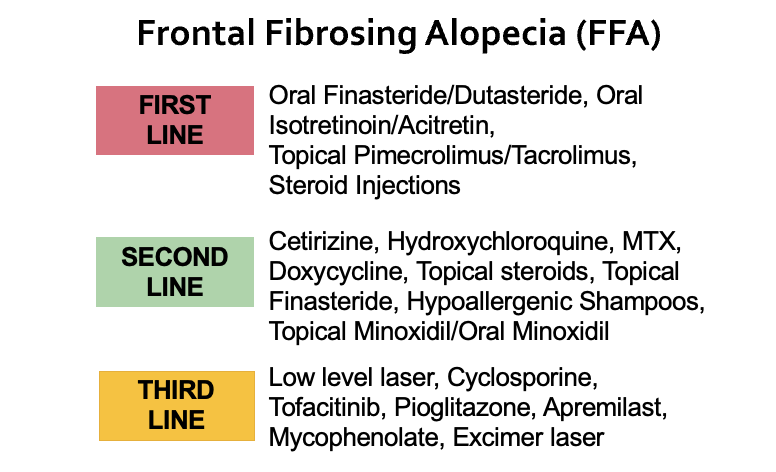Isotretinoin 20 mg and Finasteride 2.5 mg Are Similarly Beneficial in FFA - At Least at Month 3
How do finasteride and isotretinoin compare for treating FFA?
A variety of treatments are known to be helpful for FFA. Finasteride, dutasteride and isotretinoin are thought to be at the top or the list. My first line, second line and third line FFA treatment lists look somewhat like this (as of today’s date)
Very few studies have actually compared the 5 alpha reductase inhibitors directly with isotretinoin in any meaningful study. The one exception is the 2017 study by Rakowska and colleagues
Rakowska et al, 2017
This important study from Poland set out to compare the benefits of finasteride and "retinoids" (isotretinoin and acitretin) in women with FFA. The study included 29 women who were treated with a dose of 20 mg isotretinoin, 11 women treated with 20 mg acitretin and 14 treated with oral finasteride at a dose of 5 mg/daily. Interestingly, 76% of patients treated with isotretinoin, 73% of patients treated with acitretin, and 43% of patients treated with finasteride had their disease halted over a 12 month observation period.
Rokni GR et al, 2022
We turn now to a 2022 study by Rokni and colleagues which attempted to again address the issue of whether finasteride is better than isotretinoin or isotretinoin is better than finasteride or whether the two are in fact pretty similar.
This was a multi-center single blinded, randomized, active controlled trial study of 31 FFA patients seen from June 2018 to June 2020.
Patients were randomly divided into two treatment groups. The 16 patients in group A (16 patients) were treated with 20 mg Isotretinoin daily with topical tacrolimus twice daily. The 15 patients in group B were treated with finasteride 5 mg once daily and tacrolimus twice daily. Patients were followed up for 12 weeks.
Evaluation of the treatment efficacy was based on both patient ratings and physician ratings. Patient Global Assessment and Physician Global Assessment scales (severe = 0-24%, moderate = 25-49%, mild = 50-74%, almost clear = 75-99% and clear = 100%) were employed. Baseline photography was done prior to initiating therapy. Serial photography was performed at subsequent follow-ups at month 1, months 2 and month 3.
RESULTS
Thirty-one patients (2 men and 29 women) with FFA were evaluated in this particular study. Patients in group A (16 patients) had a mean age of 39.19 years and the 15 patients in Group B had a mean age of 41.47 years. The mean disease duration of the groups was 21.94 months and 21.93 months, respectively. Statistical tests showed that the study groups were not significantly different in terms of menopausal status, disease pattern and disease severity (P-value > 0.05).
At week 4, Physician Global Assessment and Physician satisfaction ratings indicated that the group A (isotretinoin group) was better than group B (finasteride group) but it just barely met statistical significance with a p-value = 0.038. At 12 weeks, physician satisfaction was not statistically different in group A patients compared to group B patients. Patient satisfaction and patient global assessment scores were not statistically different at 12 weeks
Conclusion and Comments
This is an interesting study. For those rooting for one FFA treatment over another, this study leaves us a bit disappointed. The reality is that this study has short follow up and is rather small. Nevertheless, it keeps finasteride and isotretinoin right up there at the top of the list as good treatments for FFA. The study does not really alter the views of my first list, second line and third line hierarchy.
After 1 month, there is a suggestion that perhaps isotretinoin is better than finasteride but it just snuck in at 0.04. The reality is that although I care about how my patients are doing at month 1, month 2 and months 3, I also care how they are doing at year 1, year 2, year 3 and years 10, 20 and 30. The follow up here is short and perhaps benefits of one treatment over the other may become clearer over longer periods of follow up.
Long term follow up in FFA is so important as this disease loves to run right under the radar. I see many patients every day of my practice whose disease looks pretty calm and then they proceed to lose ¼ cm of the hairline by the time I see them again. Long term follow up is really critical in FFA studies. 3 month data is not long enough - but it’s a wonderful start.
I like this study because the authors bravely set out to do what is so desperately needed in our field – conduct a randomized study of therapies. I hope that the authors follow patients even longer and commend them for this leap into an area of scarring alopecia that rarely gets done – the randomized trial.
REFERENCE
Rokni GR et al. Evaluating the combined efficacy of oral isotretinoin and topical tacrolimus versus oral finasteride and topical tacrolimus in frontal fibrosing alopecia - A randomized controlled trial. J Cosmet Dermatol. 2022 Jul 11.
Rakowska A, et al. Efficacy of Isotretinoin and Acitretin in Treatment of Frontal Fibrosing Alopecia: Retrospective Analysis of 54 Cases. J Drugs Dermatol. 2017.
This article was written by Dr. Jeff Donovan, a Canadian and US board certified dermatologist specializing exclusively in hair loss.


